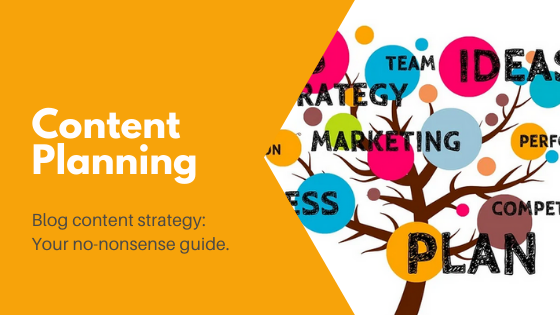Learn how to develop your own blog content strategy — with examples of blog goals and how to measure success!

Your digital marketing isn’t complete without a blog
Whether you’re a small startup (or freelancing solopreneur), medium-sized business, or large corporation – there’s no escaping the need for great content. Or rather the need to create great content for your brand. That’s why, at some point or another, you’re probably going to engage in blog content marketing.
While a blog is just one of many moving parts in a solid content marketing plan, it can be the most effective—if not most powerful—tool in your entire online marketing arsenal given, of course, that you’ve prepared properly. In other words, you need a sound blog content strategy to guide you.
What is a blog content strategy?
A blog content strategy covers the A to Z of blog content planning.
We’re talking everything from brainstorming ideas and choosing the types of blog content you want to create to writing short- and long-form blog posts; optimizing pages for search engines; promoting content online; evaluating performance; and even rewriting posts for better results.
Put another way, planning your blog content provides the structure you need to stay focused and results-oriented. But it’s also for administrative purposes like keeping track of ideas and changes as they arise.
New to blog content planning? Here’s how to develop a blog content strategy in just 8 steps!
High-quality blog posts don’t just happen—they’re carefully researched, tactically crafted, and then thoughtfully pieced together. And as you can imagine, it’s time-consuming work.
The last thing you want is to have poured hours into writing content that doesn’t bring about desired results.
That’s why you need a plan.
A plan provides you with much-needed structure and direction, so that you can be both efficient and effective.
Here’s what you need to know about creating your own blog content strategy.
Step #1: List out what you want your blog content to do for you
As with any other plan, you need to know what you want to achieve in order to create suitable types of blog content. That’s why a great blog content strategy begins with detailed goals.
Examples of blog goals:
- Raise brand awareness
- Drive organic traffic to your website
- Expand your reach to a wider, international audience
- Establish yourself as a subject matter expert
- Earn trust and gain authority in your field
- Educate potential customers about your products, services, or other initiatives
- Direct readers to do something like download an app, visit your store, subscribe to marketing emails, etc.
- Generate marketing qualified leads and increase sales
- Keep stakeholders updated on business happenings that matter to them
It doesn’t matter if you have one core goal or a combination of the above, your goal(s) will guide everything from the types of blog content you create to the writing style you use.
✅ Pro Tip: While setting overarching goals for your blog are a great starting point, it’s definitely worth taking the extra step of outlining the purpose behind individual blog posts. Post-specific goals ground you and give your writing direction.

Step #2: Set up your blogging content calendar
A blog content calendar is basically your publication schedule. And in this step, you simply decide how frequently you plan to publish new content.
Your blog content calendar can be as detailed as pre-selecting the days, times, and blog topics several months in advance or as basic as a list of blog topics with desired publication date.
Your blogging calendar can be as strict or flexible as you need it to be. What matters is that your plan should keep you motivated, help you stay on schedule, and ensure consistency. You want to blog regularly, not sporadically.
✅ Pro Tip: You don’t need to invest in fancy editorial calendar apps or software to help you stay on track. A good, old-fashioned desk pad calendar, monthly planner, or dated journal will work just fine!
Step #3: Choose what goes on your blog
What kind of content will live on your blog? That’s an important question because it influences the types of blog posts you’ll create.
Will you focus on writing evergreen content? Or will your blog be home to timely and seasonal content (these are current or trending topics that will eventually lose steam) as well as strategic content?
Strategic content includes blog posts that tell, enhance, or reinforce your brand story; promote specific offers; or that soft-sell products and services.
15 popular (and highly-effective) types of blog posts
In alphabetical order:
- Behind-the-scenes stories
- Case studies
- Checklists and cheat sheets
- Definition or explainer posts
- How-to guides and tutorials
- Infographics and video content posts
- Interviews
- Listicle content
- Long-form blog posts
- News and updates
- Promotional posts
- Roundup and resource posts
- Seasonal blog posts
- Surveys and polls
- Tips and tricks
✅ Pro Tip: The best blogs aren’t just useful. They’re also visually appealing and offer variety. In simple terms: Your blogs shouldn’t be comprised of text and text only. They should include high-quality images and, if possible, even video content.
Step #4: Get to know your audience
Let’s be honest: Nothing hurts quite as much as writing really great posts that don’t get read. At the end of the day, you want your content to be consumed. You want people to enjoy, appreciate, or benefit from your blog. Equally, you want to benefit from that traffic.
Newsflash: The only way to achieve that is if you know who you’re writing for. So who make up your audience? And what does their behavior on your website tell you about the kind of content they’re looking for?
✅ Pro Tip: Anticipate where different readers might be in their purchase journey; what their interests as well as pain points are; and what they’re hoping to find or solve—their search intent—at that moment.
Step #5: Plan your posts
This stage of your blog content strategy is where the real work happens. Everything you did in steps 1 to 4 were to prepare for this very moment, namely picking your blog topics and then actually writing about them!
There’s so much to cover here, but we’re going to keep things short and sweet:
First, map out the categories your chosen topics fall under and brainstorm appropriate tags.
Second, consider the format, layout, blog post length and – if applicable – calls to action on your posts. What would work best for your target audience given your post-specific goals?
Third, there’s the all-important, can’t-skip-or-we’re-bound-to-fail part of doing your keyword research. Be strategic! It’s a lot harder to rank for the keywords you want than you’d imagine, so be prepared to compromise and think about creative ways you can get your post to rank. In short: Keep keyword competitiveness in mind.
Finally, don’t forget to scope out your competition. What are they writing about? Are there gaps you can fill? What can you improve upon?
✅ Pro Tip: It’s not just about what you write and how you write it, i.e. your brand voice. Your blog posts must be easy to read but also optimized for search engines—otherwise no one’s going to find them!
Suggestion: Hire a content writer
Writing high-quality content that’s appealing to your audience and also optimized for search engines isn’t easy. In fact, unless you have all that extra time for research and writing, it’s so much more convenient to outsource your content needs to a freelance content writer. No stress, no hassle—just awesome content your readers will love!
Step #6: Promote your newly-published post
If you’re active on social media sites like LinkedIn, Facebook, Twitter or participate on forums, then don’t forget to promote your blog posts on those platforms.
If you send out marketing emails (and you really should be doing this – here are a few reasons to build an email list ASAP), include links to your latest posts in the newsletter.
✅ Pro Tip: Promote your posts where your target audience tends to hang out online. Refer to the reader profiles you created in step 4 to make sure you’re marketing your content in all the right places.

Step #7: Monitor your blog’s performance
Hitting ‘publish’ doesn’t mean your work is done. (Unfortunately!)
In fact, there’s still much to do including making it a habit to evaluate how your blog posts are doing.
The first step of this process is to define how you’re going to measure success.
Common measures of a blog post’s success include:
- Pages per visit: How many views did a post get? How many pages were viewed per visit?
- Timed metrics:
- If the goal is to increase engagement, you’ll look at how much time a reader spent on your page and how they moved around your website from their point of entry.
- You’ll also track how a post performs over time, e.g. from week-to-week or from month-to-month.
- Keep an eye out for backlinks and how that’s growing over time.
- Sources of traffic:
- Where are your readers coming from? How do they behave once on your site?
- Leads / subscribers: Did you acquire any new leads or subscribers from your blog? Which of your posts has the highest conversion rate?
- Comments: What are readers saying in the comments?
You can then use the above observations to improve your blog content strategy—and get better results over time!
✅ Pro Tip: Rome wasn’t built in a day and neither is a successful blog. It takes time, frequent blogging, consistent effort, and persistence to gain momentum and then stay on top.
Step #8: Check in on old blog posts
Blog posts aren’t something you publish and then forget about. They’re dynamic and as such require regular maintenance. Information needs updating, keywords might have to be adjusted, links need cleaning, and sometimes you just need to improve what you wrote oh-so-long ago. After all, keyword trends, popularity and competitiveness change over time.
✅ Pro Tip: Reviewing old blog posts should be included in your blogging schedule. Mark it down on your content blogging calendar so you don’t forget!